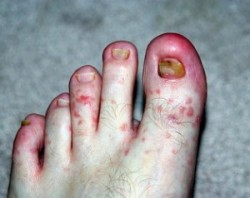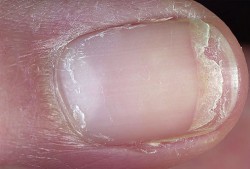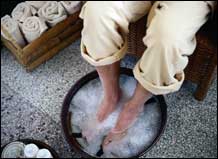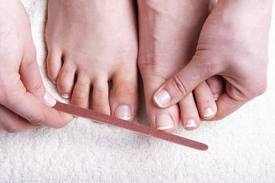Archive for the ‘Nail Fungus Treatment’ Category
Children and Nail Fungus Infections
Children and Nail Fungus Infections
 Although it is far less likely than not that a child will contract a nail fungus infection, it does happen. Onychomycosis, or nail fungus, is more commonly an adult disease, but as children spend a great deal of time getting into things they shouldn’t and playing in the dirt, they have as much potential as anyone else to attract the fungus that causes the infection.
Although it is far less likely than not that a child will contract a nail fungus infection, it does happen. Onychomycosis, or nail fungus, is more commonly an adult disease, but as children spend a great deal of time getting into things they shouldn’t and playing in the dirt, they have as much potential as anyone else to attract the fungus that causes the infection.
For kids, the infection is more of a social affliction than anything. Other children may see the infected nail and want to avoid the person with the nail fungus because they think they’ll get sick. This can be really rough on a child’s self esteem.
And as the nail fungus infection develops, the nail can become painful and even possibly fall off. So treating the infection, or better yet avoiding the infection entirely is the best solution.
The infection tends to show up as whitish or yellowish spots on the nail, then gradually grows to cover the nail surface entirely so that the nail is opaque. The nail will then become thicker and more brittle, possibly flaking or crumbling at the edges. Depending on the type of infection, the nail can disengage from the nail bed and fall off, which can be very painful.
How Can I Prevent My Child From Becoming Infected?
Start by teaching your children good hygiene. Make them wash their hands when they come inside after playing. This will quickly remove any spores they may have picked up outside. Get a soft nail-brush and show them how to scrub underneath their nails as well, as that can be a very common area that nail fungus attack.
Keep your children’s nails trimmed close to the tips of their fingers and toes, as the less exposed nail there is, the less surface is available to the spores to invade.
Put antifungal powder in their shoes overnight so they don’t risk infection from wearing shoes all the time. Wash their socks in bleach to kill off anything that might be lurking in the fibers.
If you do end up with a child contracting a fungal nail infection, simple methods of controlling the disease are:
• Rubbing Tea Tree Oil on the infected nail and surrounding skin
• Soaking the infected nail in a solution of vinegar and water twice a day
• Clean underneath the nails to remove the dirt and then wipe with rubbing alcohol to kill the fungus.
If these solutions don’t have an effect, you can speak with your child’s doctor about other available treatments. Some of these, particularly the oral antifungal medications, do carry the risk of liver damage, so be careful which option you choose, and make sure your child’s health is up to the treatment.
Onychorrhexis – Brittle Nail Disease
Onychorrhexis – Brittle Nail Disease
 What is it? – When fingernails and toenails break easily because they are weak.
What is it? – When fingernails and toenails break easily because they are weak.- Why is it? – As keratin develops with protein as a component, the nail grows according to the appropriate thickness determined by the body. Your nail thickness is pretty much set at birth. Some people are born with very thin and/or fragile nails
- What causes it? – Humidity at the base of the nail is a common cause. For instance, soaking your hands (or person) in water for a long period of time (taking a bath or doing dishes) on a regular basis. Some people have a hereditary condition of weak nails. As they grow older, their nails become weaker and more prone to breakage. Some diseases and circumstances that might cause a fragile nail are:
- Hypothyroidism or low thyroid levels
- Reynaud’s syndrome
- Skin diseases, such as psoriasis
- Lack of proper nourishment
Signs of this affliction
- Flaking at the base of the nail
- The nails breaking and/or falling off
Basic Treatment
People with brittle nails should not spend a lot of time with their hands in the water. They should dry their hands thoroughly after getting them wet and they should use a mild soap when washing.
Immediately after washing and drying their hands, sufferers of onychorrhexis should apply a moisturizer to the afflicted limb. Two recommended kinds of moisturizer are:
- Standard “beauty” moisturizers, which work to soften the skin. These will provide instant relief and will assist people with this affliction greatly.
- Healing moisturizers, which both soften and infuse the skin with herbal or medicinal remedies as well as acting as a barrier between the water and the nail
Some good preventative measures are as follows:
- Wearing protective covering on hands or feet when immersing them in water
- Not participating in activities that involve being submerged in water, such as swimming.
- Protecting the hands from irritating chemicals
- Supplementing the diet with vitamins and minerals to help the nails become stronger.
- Identifying nutritional deficits that may be causing the nail breakdown and working to increase those areas
Side Effects
The only potential negative side effect of the above treatment is an allergic reaction to a moisturizer. Stay alert for irritation of the skin to indicate that there is sensitivity.
Onychoschizia – Split Nails
Onychoschizia – Split Nails
 Onychoschizia is a condition in which the nail split or falls apart easily. Typically people who have Onychoschizia have nails that are very fragile, squashy, and thin or that have funny “crumple” lines. Sufferers are more prone to nail infections. Onychoschizia is most commonly found in women.
Onychoschizia is a condition in which the nail split or falls apart easily. Typically people who have Onychoschizia have nails that are very fragile, squashy, and thin or that have funny “crumple” lines. Sufferers are more prone to nail infections. Onychoschizia is most commonly found in women.
What Causes Onychoschizia?
- Long periods of being submerged in water or chemical baths
- Poor nutrition
- Vitamin Deficits
- Applying nail polish remover
- Stress
How to Deal With Onychoschizia
- Wear protective gloves whenever working with chemicals (household or otherwise) or immersing hands in water for a long period of time.
- Use ointments or lotions that contain alpha hydroxyl acid, for instance, Lanolin or Neostrata, especially after washing your hands and/or feet
- Do not use your fingernails to dial a telephone or to type as the repeated stress will cause your nails to break
- Pay attention to how people with healthy fingernails treat them
- Wear gloves during the winter to help protect your nails from possible infection
- Trim and file your nails to a nice shape at the tip so that there is less risk of breakage.
- Do not buff the bulk of the nail as this can strip away necessary protective layers
- Taking biotin in 2.4 milligram doses as a daily supplement can help with healthy nail growth. Please note: this should not be done by women who are pregnant.
- Including a daily dose of Knox Gelatin, mixed with fruit juice, every day can help to increase nail strength.
- Taking nutritional supplements to help increase healthy nail growth
- Wearing nail polish with nylon fiber can help to strengthen and protect the nail.
Curing a Nail Fungus Infection with an Acidophilus Beer Soak
Curing a Nail Fungus Infection
with an Acidophilus Beer Soak
 A nail fungus infection is unattractive at best, annoying at worst. This is not a disease that is going to kill you. It may affect how you interact with the world if it gets to bad, for instance, if your have a very bad toenail fungus infection, it may become painful to walk, or the nerves in your feet may be mildly affected and you won’t be able to feel the floor very well. However this is not a life threatening condition, especially if it is caught early on.
A nail fungus infection is unattractive at best, annoying at worst. This is not a disease that is going to kill you. It may affect how you interact with the world if it gets to bad, for instance, if your have a very bad toenail fungus infection, it may become painful to walk, or the nerves in your feet may be mildly affected and you won’t be able to feel the floor very well. However this is not a life threatening condition, especially if it is caught early on.
A fungus, most commonly a dermatophyte, can get onto and underneath your nail and find a happy, warm, moist place to grow. Once the fungus has established itself, it turns your nail white or yellow. This is usually seen originally as a spot, but that spot grows to cover the whole nail over time. It also makes your nails thicker and more brittle, because the fungus is consuming the keratin, the protein that your nails are made of, to grow and protect itself.
So one of the biggest problems with a fungal nail infection is that it is located underneath the nail, in the nail bed. One of the most frequently suggested nail infection home remedies is soaking your feet in a combination of dark beer, vinegar and acidophilus, usually referred to as an acidophilus beer soak.
So Why Acidophilus and Beer?
The theory behind this home remedy is that by soaking your infected nails in this solution for 20-30 minutes, you allow the alcohol in the beer to soften up the nail, thus the acidophilus and vinegar can get into and underneath the nail to kill off the fungal infection.
Here is the process:
• Use a dark beer, like Guinness Stout. (Any stout will do, most people happen to know and can get this particular brand.)
• Mix the beer with a ½ cup of white or apple cider vinegar.
• Add a sachet of acidophilus culture. You can find these at your health food store. You want to find one that is 125 billion organisms. (It should say so on the packaging.)
• Stir these all together, then soak the infected nails in the solution for 20-30 minutes a day, twice daily.
• Wash the infected area thoroughly with soap and water afterward, then dry equally thoroughly.
• Put on clean socks (if it is the beginning of the day) or leave your feet exposed to light and air.
This mixture can be used up to four times before disposing of it, which will keep your costs down. Many people have claimed to cure their nail fungus infection entirely by using this simple home remedy.
What Nails Are and How They Become Infected
What Nails Are and How They Become Infected
 Our nails look like clear, hard sheathes that cover part of our finger and eventually grow out over the edge. Most people have a bit of a pinkish tinge underneath their nails. The nail itself isn’t pink but allows the color of the skin and blood vessels directly underneath to show through. This is what a normal, healthy nail should look like.
Our nails look like clear, hard sheathes that cover part of our finger and eventually grow out over the edge. Most people have a bit of a pinkish tinge underneath their nails. The nail itself isn’t pink but allows the color of the skin and blood vessels directly underneath to show through. This is what a normal, healthy nail should look like.
A nail infection discolors the nail to a whitish or yellowish color at first, then as it grows, brown and black can become part of the color scheme.
Nails are made up of keratin, the same protein that builds our hair and the outmost layer of our skin. Keratin is a strong-celled protein that is fairly diverse. For our nails, it builds this lovely sheath to protect the soft part of the nail from harm.
How Does Infection Get Into the Nail?
Really what happens is that a fungal infection gets under the nail. Just like their cousins, the mushroom, the fungal spores that grow and invade the nail bed want to be in a warm, dark, damp place to grow. We come into contact with these spores on a regular basis. Some of them are harmless and wash off with no effect to us. Others try to seek a parasitic relationship with our bodies, using us as a means to grow and spread themselves.
Most people don’t realize when or where they might come into contact with these parasitic fungal spores. The answer is, pretty much everywhere. Germs, viruses, and spores are part of the make-up of our eco-system. Having a healthy immune system is what allows our bodies to fight these things off.
The fungus that most commonly causes nail infection is called a dermatophyte. We come into contact with them every day and for most people, no harm is caused. However, for people with certain diseases, like diabetes, or who have poor circulation, or even who have been sick for a long time, so their immune system has been working overtime, these parasitic fungi find a happy breeding ground. The most commonly affected area is the toenail, as it is usually kept in the dark and surrounded by warm fabric that has the potential to hold in moisture. Fingernail fungus infections occur most often in people who spend a great deal of time with their hands in the water or exposed to harsh chemicals.
Fungus grow very slowly, so by the time the infected person notices the discoloration of their nail, the fungus has already established a fairly good hold on the nail. Usually it gets underneath the nail at the tip of the toe by working its way underneath and into the protected nail bed. It can also get into the soft tissue surrounding the nail and work its way under from there. Nail Fungus Infections aren’t incredibly dangerous, but they do take a very long time to treat, as the fungus isn’t gone until the nail has grown out entirely clear.
What can I do to prevent it?
There are lots of ways you can prevent nail fungus from getting to your nails in the first place. This is your best bet.
- Keep your nails trimmed close to the edge of the finger or toe tip. The less space there is at the edge of the nail for the fungus to get on, the less likely it will be to grow.
- Wash your hands and feet regularly and dry them thoroughly. Wear clean socks every day and make sure your shoes dry out entirely before wearing them, especially if you wear the same shoes every day.
- Wear something on your feet when in public areas that have a lot of water, like swimming pools or locker rooms. And make sure those shoes have a chance to dry out too!
If I Get Infected, How Do I Treat It?
There are a great many home remedies suggested on this and other websites. Over-the-counter remedies and medications are another good idea. If you’re going to try to treat it yourself, start working with one of these remedies and wash the affected area at least twice a day, then dry it thoroughly. Wear clean socks if it’s a toenail infection, even to the point of changing your socks a couple times a day. Right after washing your feet. And if it is possible for you to wear sandals, exposing your feet to the light also helps.
If your infection is severe or well advanced, a visit to your doctor to figure out what kind of fungal infection it is and what treatment options are available to you will be your next step.